|
July
20
After a 5:30 a.m. wake-up call, we
had coffee and tea around the campfire, looking up at the
brilliant stars. Jungle oats and toast at 6:00 and we were in the
vehicle and on the road by 6:30, before it was fully light. This
was to be our morning schedule throughout the duration of the
mobile safari. Normally I hate getting up really early, but in
Africa I never mind - I can’t wait to see what the day brings,
and you have the best chance of seeing predators in the early
hours. But with the winter temperatures in the low forties before
dawn, it was a little hard to crawl out of our warm beds.
The Toyota Landcruiser was the perfect size for
our group of seven. Two people sat on each of the three raised
bench seats and one rode shotgun in the passenger seat beside Gee
- we rotated each day who sat where. Duma the stuffed baby cheetah
and Fred the bushbaby sat on the console behind Gee; we figured
they would bring us good luck. The vehicle was completely open,
with a canvas roof and no side walls. The engine had a large
snorkel, which seemed a bit incongruous in the dry sand. There was
a cooler of drinks handy, and the tea break supplies were stashed
in metal boxes under the seats. There was a
warm wool blanket for each of us, which we gratefully wrapped
overtop all our other layers in the mornings.
|
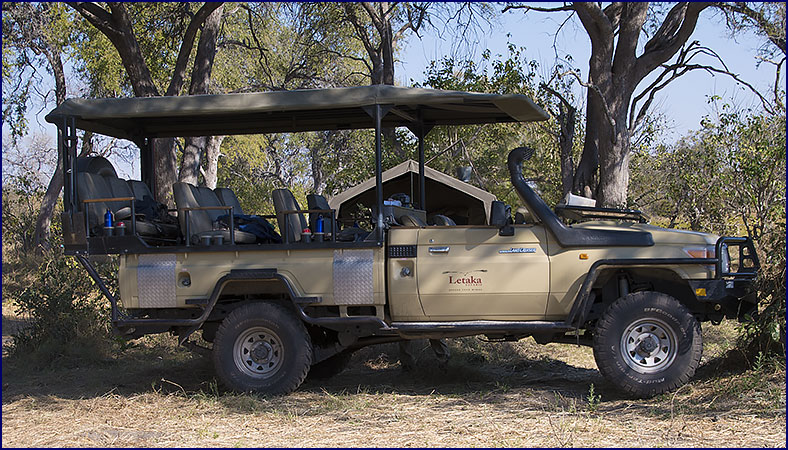
Our
trusty Landcruiser |
It was cold and quiet when we set out. As the sky lightened
and the stars faded there was a sense of anticipation; what would
we see today? A pair of thick-trunked baobab trees stood
silhouetted against a pastel dawn sky that faded from rosy pink to
shades of mauve and lavender, delicate colors like the inside of a
shell. We stopped to watch a glorious sunrise, the red orb of the
sun climbing into view among the trees. A single bird sang out,
and then another – and soon the air was filled with birdsong.
|
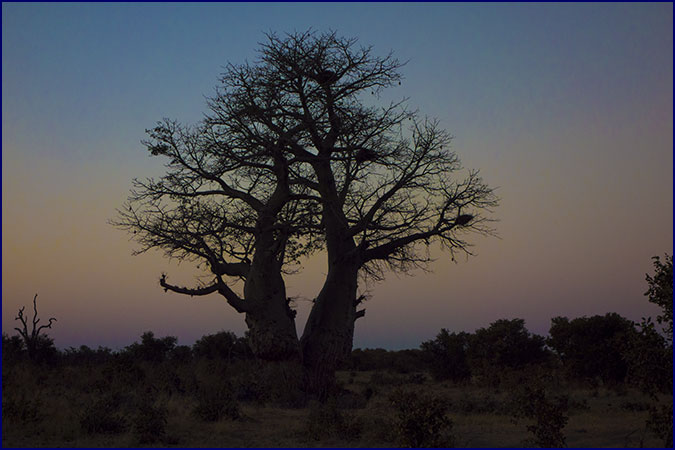
Baobab
Dawn
|
The
ubiquitous impala were there to greet us; these lovely antelopes
were very numerous and we encountered them on just about every
game drive. We saw a myriad of birds, which we would get better at
identifying as time went on. A kori bustard was walking near the
road; he had brown variegated feathers, long legs and a stylish
topknot. The heaviest flying bird in Africa, the kori bustard is
about the size of a turkey, but far more attractive.
|
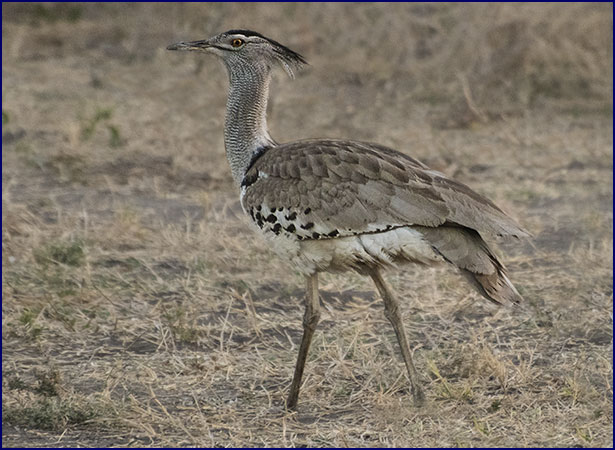
Kori
Bustard
|
Several giraffes were browsing on the trees, and we were
able to get quite close to these splendid creatures. We admired
their luxurious eyelashes and their knobby horn-like prongs, which
were covered with skin and hair. Oxpeckers clung to their necks,
flapping their wings and picking for ticks. Gee told us that
giraffes have excellent eyesight, capable of seeing predators up
to two kilometers away.
Jineen
caught a glimpse of motion in the tall grass way off to our left;
it was a pair of black-backed jackals, barely visible in the
distance. “Good spot!” Gee congratulated her, and we watched
as they moved toward us. Closer and closer they came, finally
crossing the road right in front of us, pausing to pose for a
photo. They were exquisite. It
is hard to understand why these beautiful foxlike creatures have a
negative reputation.
There were birds everywhere. Swainson’s spurfowl and
red-billed francolin are among the most common and look very
similar; Gee said the spurfowl have longer spurs. Both are about
the size of a bantam chicken, and throughout the trip we saw them
in abundance, running around on the ground foraging, and flying up
into the bushes when startled.
A group of crested francolins
walked alongside the road; these are less common and quite
beautiful, with many shades of mottled tan, brown and chestnut.
Gee pointed out a more ordinary lone red-billed francolin among
them; he told us that sometimes a red-billed francolin hen will
lay her eggs in other birds’ nests, so this one had probably
been raised by the crested bunch, and didn’t know he was any
different.
|
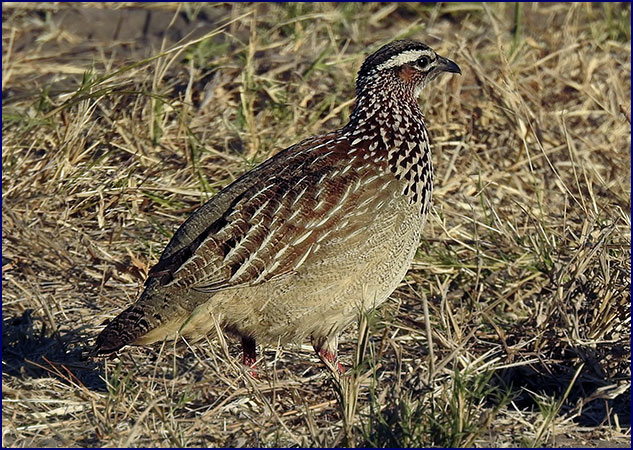
Crested
Francolin
|
A blue-eared starling perched on a twig, his sapphire
feathers iridescent in the sunlight. A yellow-billed hornbill
posed for us in a tree, somehow more handsome and dignified than
his red-billed cousins. A female northern black korhaan was
perfectly camouflaged against the underbrush; these attractive
long-legged birds with mottled feathers look somewhat similar to
the kori bustard, though quite a bit smaller.
|
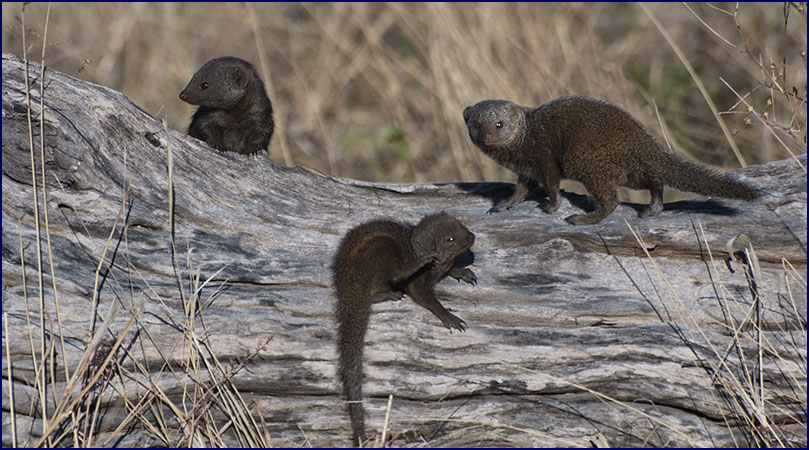
Dwarf
Mongooses
|
A
family of dwarf mongooses were out sunning themselves on a log
beside the road; a mother with about four half-grown youngsters.
They watched us with inquisitive expressions. These small
ferret-like mongooses are dark brown in color and have reddish
eyes. One of the youngsters stretched languorously, then scratched
himself thoroughly - presumably he had fleas. Several of them were
playing hide-and-seek, darting in and out of holes in the log.
We passed a pair of steenboks, one of the smallest
antelopes. They are tiny and delicate; the fawn-like adults are
less than two feet tall. The female was lying down and the male
stood beside her. He sported tiny spiky horns, which did not look
like they would be very formidable in a fight.
|
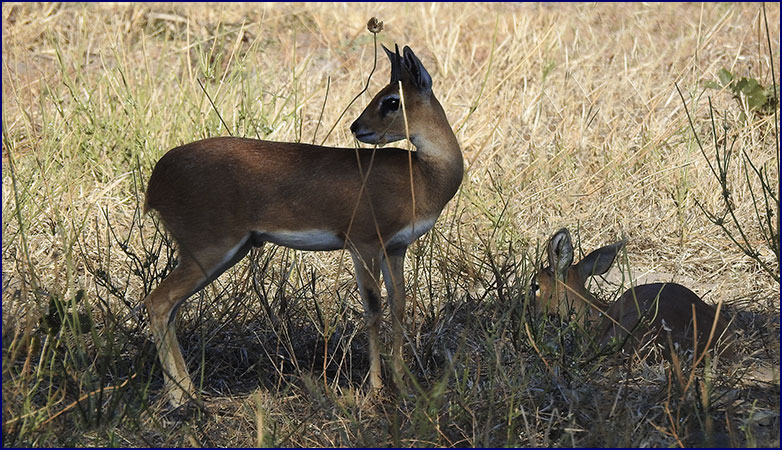
Steenboks
|
We stopped by a hyena den, but nobody was home. Like many
other animals, the hyenas don’t dig the holes themselves but
take over dens dug by aardvarks. Nearing Leopard Rock, we swung by
the lion kill we’d seen the previous day, but the lions were
gone. The vultures were still there though, a white-backed (the
better looking of the pair) and a hooded. They were having their
turn at the ribcage, the last remains of the carcass.
Following paw prints in the sand, we drove around the ridge
searching for the lions up on the rocks, but they were nowhere to
be seen.
We checked out leopard’s den, and once again found her
home. Using the binoculars to look into the entrance of the cave,
we could see her spots. She was moving around a little; we thought
perhaps she was grooming herself. But then she turned, and we
could see that she was licking a tiny baby. There seemed to be
just one cub, and when she shifted positions we were able to make
out his little face and tiny paws. He couldn’t have been more
than two weeks old. It wasn’t easy to see into the den, but with
the binoculars we were able to see the baby despite the dim light.
The leopardess groomed her cub for
quite a while, turning him over and licking him thoroughly all
over. After a while she stretched out, and the baby settled down
to nurse. A wonderful and beautiful occurrence which has taken
place every day for thousands of years, and we are among the lucky
few who have had the privilege to witness it.
Moving
on, we picked up some more lion spoor, and followed these tracks
down the dusty road. Presently we caught a glimpse of tawny
movement and saw a female lion, and then two more, stalking across
the plain. We followed the three lionesses on a parallel path,
watching from a distance as they moved stealthily through the tall
grass. They seemed to be stalking an ostrich, sneaking ever
closer, but it saw them and took off. After a while the lions
moved away out of sight.
We stopped for a tea break; no elephants
while checking the tires this time. Our group reflected on what a
terrific guide Gee is. He does it all: drives, finds elusive
wildlife, tracks animals and tells amazing stories.
He has a number of interesting sayings:
If someone sighted an animal that was hidden or hard to
find, Gee would compliment them with “Good spot,” though this
was occasionally said in sarcasm. If we expressed a desire to see
some animal or behavior pattern that was extremely rare, he would
nod and say “That would be very good,” which was his polite
way of telling us “Not a snowball’s chance in hell.” We
noticed that when we called Gee by name to ask him a question, he
would turn and answer, “Hi?”
I loved the way that whenever we witnessed something really
special and unusual; he would exclaim “My God, that is amazing”,
or perhaps “Unbelievable!”
|
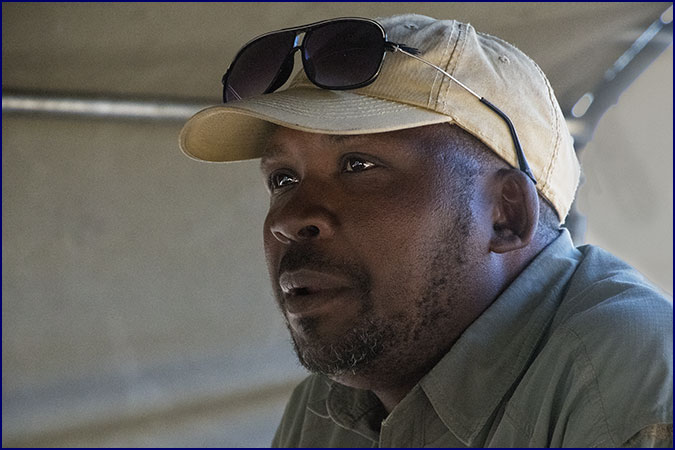
Gee |
I noticed that Gee did not have his camera on this trip;
last time he had carried a nice Nikon with a good telephoto lens,
and seemed to enjoy taking pictures. When I asked him about it he
told us he’d had to sell the camera to buy bricks to build his
house. What a shame.
After tea we tried to find those
lionesses again. Gee drove around to the area we had last seen
them headed, but there was no sign of them. We passed another
safari vehicle, and one of the guests exclaimed “Look, a
cheetah!” He was pointing at Duma, proudly perched on the
console with Fred.
|
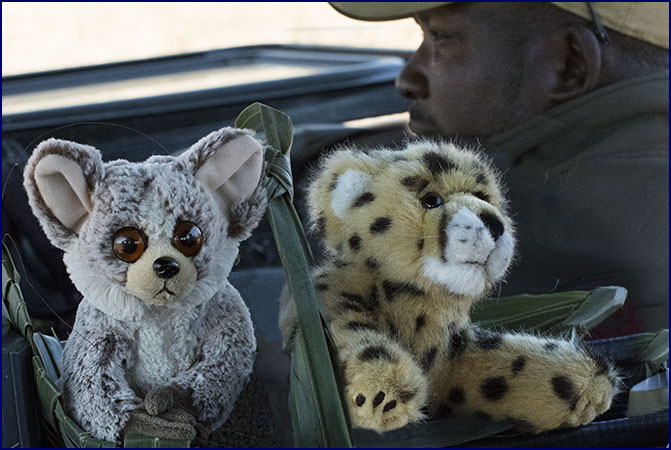
Fred
and Duma |
We saw a variety of birds; some of the new ones Gee
identified for us included a rufous-naped lark, a Meve’s
long-tailed starling and a tiny desert cisticola. We got a good
close view of a black-winged kite as it perched in a tall tree, a
beautiful grey raptor with black wings and red eyes. A red-billed
hornbill sat in a bush right by the road.
We were skirting the plain where we had seen the lionesses
stalking, hoping to find them again. Suddenly I saw a familiar
profile. “Stop, a lion!” I exclaimed, pointing. There was one
of our lionesses, sitting under a bush a good ways from the road.
“Good spot, Phyllis,” said Gee, the highest of praise. Soon
another lioness appeared, sitting up out of the tall grass where
she had been hidden, and then a third. They were gazing at a herd
of impala in the distance, which oddly enough had one lone
wildebeest with them. Gee told us that the dominant male
wildebeest defends his territory alone; the females will breed
with the one that has the best territory. The solitary bulls hang
out with the impala for protection - many eyes are more likely to
see predators.
We watched the lions furtively sneak closer, weaving
silently through the underbrush toward the impala. Then they moved
into the dense brush and out of sight, presumably planning their
attack. The impala were on the alert, all staring in the direction
where the lions were hiding; they must have caught their scent.
They moved away and took shelter under an acacia tree, watching
the bushes suspiciously.
Gee gave us some insight into
impala behavior. They
have a short memory, he told us. Look,
something moved, they think. Could
that be a lion in there? They all look alertly in the same
direction. But then a few minutes go by and some start to think, Did
we really see it? And some of the others, who didn’t see the
movement at all, don’t believe it was there. Soon they all lose
interest, and while they are not paying attention the lions can
sneak closer.
We waited in anticipation for the ambush, but the element
of surprise was gone and the impala moved off. The lions realized
the impala knew they were there, so content to just wait, they lay
down for a nap. Lions are very patient hunters - they would try
again later.
Further on, we found another lioness sleeping under a bush
by the road, taking advantage of the small spot of shade. She
looked very thin, and Gee said she was really old. Nearby we got a
glimpse of the honeymooning lions, the pair that we had seen
courting the previous day, just sitting quietly. Typically while
she was in estrus they would have intercourse up to fifty times
per day; at that rate I suspect they skip the foreplay.
Crossing an open treeless area, we came upon a male ostrich
right by the road, sitting down with his body on the ground and
his neck and head sticking straight up. As we approached he stood,
looked around and shook himself, and pranced off in a somewhat
prissy manner. This was the closest I had ever gotten to an
ostrich, and I was really impressed. His legs were enormous and
strong, like the hind leg of a horse, and his absurdly long neck,
tiny head and pink bill made him look cartoonish.
Patty asked Gee if he had ever eaten an
ostrich egg; “Yes,” he told her. “Was it good?”
Patty asked him; "No!" answered Gee emphatically.
A pair of secretary birds were walking through the short
grass. These tall slim birds are light grey with black legs and
wingtips. They are quite handsome, but there is also something
slightly outlandish about them. They have a crest of long loose
black feathers on the back of their heads that gives them a
distinctive look. They are birds of prey and can fly well, but you
often see them walking around like a tall thin chicken.
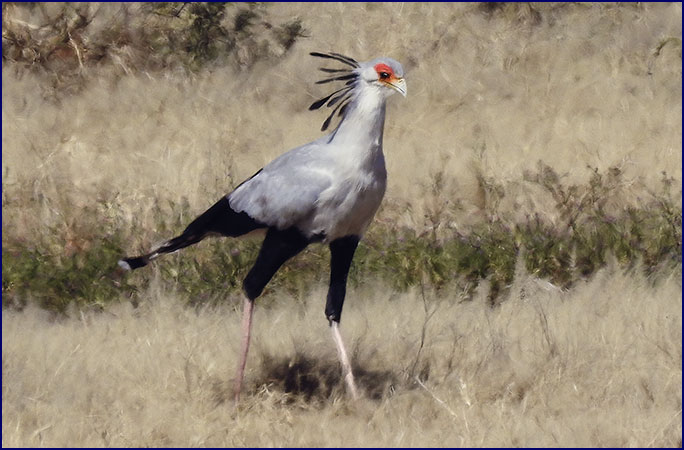
Secretary Bird
|
We swung back by Leopard Rock, but the mother leopard was
not there now. Perhaps we could come by later and check on her.
We stopped for lunch at the Bushman's Baobab tree; I had
been hoping we would get to have a closer look at that magnificent
tree. Phillimon and
Pula were waiting there with the camp vehicle, and had lunch all
ready for us. The camp chairs were set out in a semicircle, and we
relaxed in the shade of the magnificent baobab while we ate.
It was awesome. The trunk of this mighty tree was at least
fifty feet around, and it provided an oasis of shade in the dry
plain. The baobab is a very spiritual tree; the San people, or
Bushmen, pray to it for good hunting. I could see why they believe
spirits live in it. Gee told us that the tree is around 1200 years
old; I tried to imagine the things it must have seen. It was
magical.
|
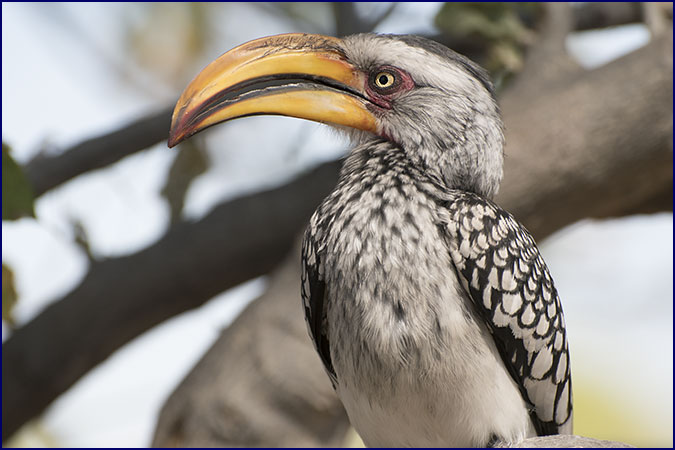
Yellow-billed
Hornbill |
A yellow-billed hornbill sat in a small tree nearby and
begged for food, looking at us intently with an intelligent
expression. He was quite handsome, with white feathers delicately
edged in black, and an impressively big curved bill. We would have
liked to share our lunch with him but it was strictly against the
rules. (I may have accidentally
dropped a few crumbs) A tree squirrel ran up and down the massive
trunk, then came down and approached us, doing a little begging of
his own. We took a group photo, with us all standing stretched
across the tree’s mighty girth. I collected a rock to take home
for the cairn in my yard.
After lunch we cruised past Leopard Rock once more; Mom was
back! We could see her spotted coat in the den, and she seemed to
be sleeping. Swinging by the remains of the lion kill, we saw the
vultures now stood watch from the top of a dead tree. Gee picked
several twigs off of a plant and passed them back to us; it was
wild basil, also locally known as the perfume plant, and it had a
lovely spicy scent.
We stopped back by the lioness that was sleeping by the
bush, but now the shade had moved around and she was in the full
sun, apparently too tired to get up and move. She almost looked
dead, and she was so thin we could see every rib. After a while
she did get up and move to the shade, but it seemed a big effort.
We felt sorry for her.
A brown
snake eagle regally surveyed his territory from atop a dead tree,
a fierce-looking brown raptor with a bright orange eye. A black
and white magpie shrike perched on a twig, with his long tail
dangling down. To complete our hat trick of shrikes we saw both
the helmeted and white-crowned varieties.
|
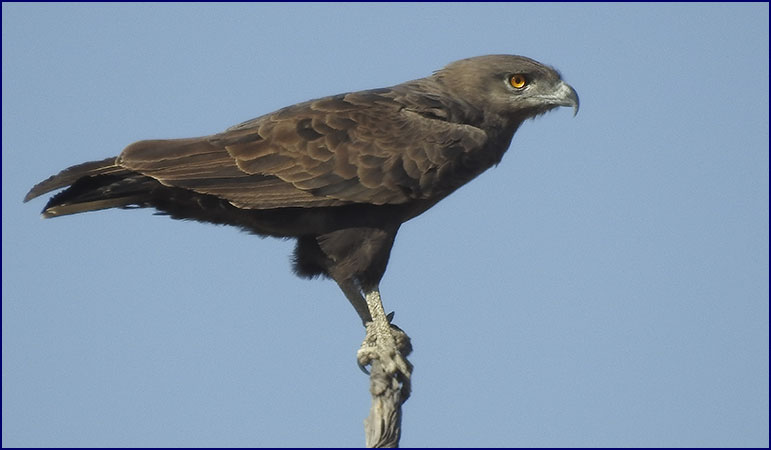
Brown Snake Eagle |
We went through a lovely patch of woods and Gee stopped to
show us Seretse Khama’s campsite; it was the spot where the
former Botswana president used to stay when visiting the area.
Just before this trip I had watched the movie A
United Kingdom which tells the story of this inspiring leader;
I would encourage everyone to see it.
We visited the waterholes; the elephants were not in
attendance this afternoon but the giraffes were. I was hoping to
get a chance to watch some of these impossibly tall, elegant
creatures drinking. First
a lone giraffe approached the water and stood deliberating whether
to take a sip; it seemed a tough decision but after a while he
decided against it and strode off across the plain. Then another
came, a big bull, and stood quite close to us gazing at the water,
filled with indecision.
Giraffes are at their most vulnerable when lowering their
heads to drink; this is when lions may attack, so they quench
their thirst only after careful reconnaissance and much
deliberation. As he watched and waited, we had a close-up view as
half a dozen oxpeckers clung to his neck and picked at insects and
ticks. Gee told us that the more common red-billed oxpecker will
always stay on one side of the neck, while the yellow-billed
variety will move from side to side.
Presently more giraffes arrived,
three females and a half-grown youngster. They walked up beside
the male and looked carefully around, stared at the water
wistfully for a while, and then all four of the adults turned and
walked away in a single file line, without anyone having even a
sip. This was getting ridiculous!
But one giraffe stayed behind, the half-grown baby. He may
have been bolder than the adults, or more naïve, or perhaps he
was just thirstier. He spread his front legs out wide in order to
get low to the ground, put his head down to the water, and drank
his fill.
Another large male giraffe
wandered close to us, munching on the trees and occasionally
glancing down at us curiously. He bit off twigs and leaves with
velvet lips. The oxpeckers had groomed his mane until in lay in a
swirly pattern that looked almost like it was braided.
Giraffes have very individual color patterns, Gee told us,
and to identify them the researchers take photos of the spots
between the eye and the ear. For leopards they use the spots
between the eyes to identify them, and for cheetahs it is the
markings just below the eyes.
A blacksmith plover picked his way along the shore, his feathers a
bold pattern of black, white and grey. Other new birds included
the southern grey-headed sparrow and the capped wheatear. A pretty
Namaqua dove scratched in the sand, and an Egyptian goose dabbled
in the shallow water.
|
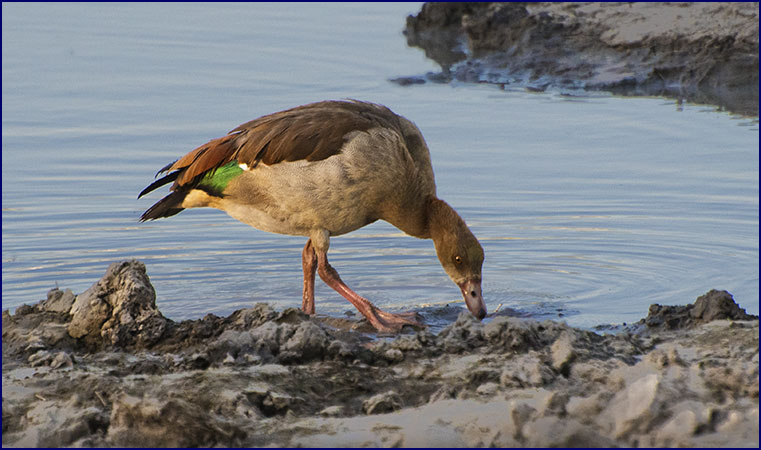
Egyptian Goose |
We moved on, heading back toward camp. We stopped briefly
at another waterhole, this one occupied by a small herd of
wildebeest and a few impala. A pair of Cape turtle doves drank at
the edge of the water, way less shy than the giraffes had been.
We noticed some activity on the far side of the plain;
through our binoculars we could see a table and chairs set up and
people gathered round them; Tara thought it was a wedding, but Gee
said it was a lodge having dinner out in the bush. Near the Savuti
gate we passed a group of locals playing a game of soccer on a
sandy field that had been cleared for that purpose.
On the way back to camp we passed
a pile of old bleached elephant bones. Rob asked Gee to stop so he
could get out for a better look; he lifted a huge leg bone and
examined the pelvis.
|
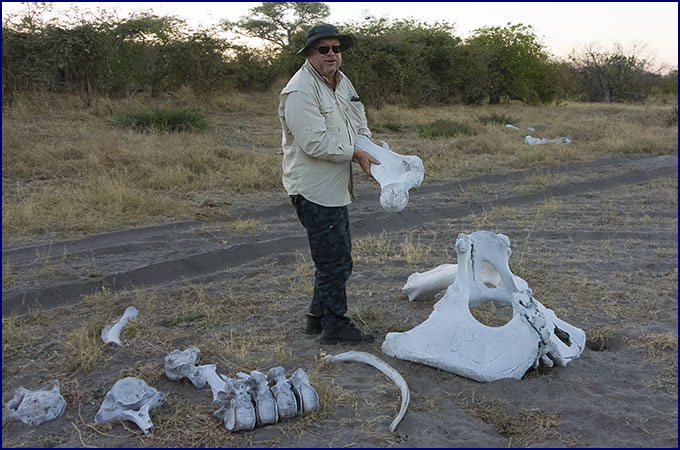
Rob at the
Elephant Graveyard |
As the light grew dim two huge kudu bulls crossed the road
in front of us, walking regally, their massive twisting horns like
polished ebony. These large magnificent creatures are my favorite
of the antelopes. They have thin white stripes on their sides,
shaggy manes on the underside of their necks, and the males have
spectacular long curving spiral horns.
|
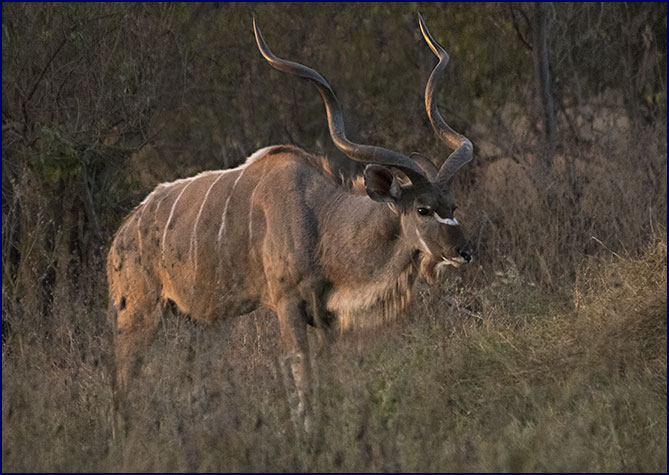
Kudu bull |
We came around the hill and crossed the dry sandy riverbed
into camp just after the sun went down. The hill loomed dark
against a fiery sky, and we could see the cheery twinkling of the
lanterns. The campfire beckoned us.
We put away our gear, grabbed a G&T (gin and tonic) or
a glass of wine, and pulled our chairs close around the fire. Again
we started with the question; what was your favorite thing today?
Most of us agreed it was watching that baby leopard. Paula had
recorded it all on video, and it had come out surprisingly good.
The stars were incredible, and Gee
was very knowledgeable about the constellations. He explained how
to find due South: You trace an imaginary line lengthwise through
the Southern Cross and extend it down to the horizon. Then you
link the two Pointer stars, and trace a line perpendicular to that
downward. Where the two lines meet is South.
At dinner the food was very good, but the setting and
ambiance made it spectacular. We asked Gee about his scariest ever
wildlife encounter; he told us a story about being charged by an
angry elephant. Having no way to escape, he sat down on the ground
hoping to seem less of a threat. The elephant stopped right in
front of him and kicked dirt on him; he sat without moving until
it finally calmed down and went away. Wow, that must take some
nerve!
We refilled our wineglasses and
went back out to the campfire, enjoying the company and
conversation. Gee told some stories about his worst ever clients.
I can’t remember now who they were - I hope it wasn’t us! We
could hear the sharp cracking sound of elephants breaking branches
not far away. Above us the Milky Way illuminated a path to the
heavens.
|